April 5, 2015
by Carole Zangari -
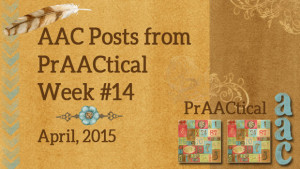
Monday – PrAACtically April: A Month of Core Tuesday – Core Vocabulary Resources for April Wednesday – Video of the Week: AAC and ASD Thursday – How I Do It: Making a Back-up for High Tech AAC by Jeanne Tuthill Friday – Beyond World Autism Day
Filed under: PrAACtical Thinking
April 3, 2015
by Carole Zangari -
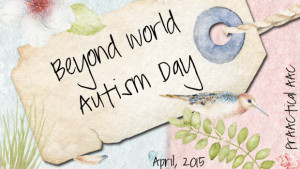
Today is a great day to appreciate the experiences we’ve each had with individuals affected by autism and their families. They come to us to learn, but, in reality, they teach us so much. What are some of the ways they’ve taught or inspired you?
Filed under: PrAACtical Thinking
Tagged With: ASD, World Autism Day
April 2, 2015
by Carole Zangari -
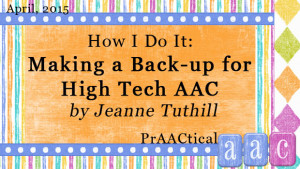
If you’ve ever woken up in the middle of the night sweating over one of your AAC clients who doesn’t have a back-up communication tool, then this post is for you. Jeanne Tuthill is back with another prAACtical suggestion, this time on the importance of ensuring that people with AAC needs have communication options when their technology isn’t available or appropriate. In keeping with the generous spirit of the AAC field, Jeanne also shares her files for this project. Enjoy! How I Do It: Making a Back-up for High Tech AAC Each time I teach my graduate class I try to invite at least one AAC user in as a guest speaker to share their story with the students in the class. It never ceases to fill my students with awe and appreciation for the challenges that AAC users face on a daily basis. My students often list it as... [Read More...]
Filed under: PrAACtical Thinking
Tagged With: AAC app, back-up, high tech, Jeanne Tuthill, LAMP Words for Life, SGD
March 31, 2015
by Carole Zangari -
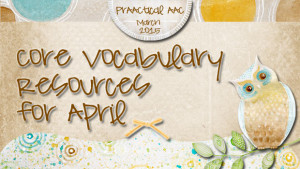
We are leaving March behind and getting ready to focus on a new set of core vocabulary words for April. Whether you are following along with the 2013 Year of Core (12 words/month) or the 2014 A(nother) Year of Core: (16 words/month; Different than the previous year’s core words), or just getting started, here are some helpful resources. Our words for this month are listed below. 2013 List: big, busy, do, drink, feel, he, in, make, out, some, tell, who 2014 List: blue, brother, close, family, head, last, long, no, old, right, scared, soft, thing, top, wash, whole You can download the blank template to add in your own symbols for each of the words or check out the ones made for a variety of AAC symbols. Templates for you to plug in your own symbols: 2013 words, 2014 words Minspeak/Unity version: 2013 PCS versions: 2013; 2014 Symbol Stix version: 2013... [Read More...]
Filed under: PrAACtical Thinking
Tagged With: A Year of Core Words
March 30, 2015
by Carole Zangari -
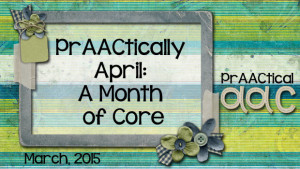
April is right around the corner, making this the perfect time to prepare some materials for practicing a new set of core vocabulary words. Rachael Langley is back to share some fun ideas for easy things to do to put that core vocabulary to work. She’s made two calendars, one with a focus word for each week and another one that covers many of the words in the April Year of Core Vocabulary list. These are great tools to print and share with classrooms or families. Click on the image to download the calendars or visit the Downloads sections of the eToolBox. Thanks for these great resources, Rachael!! Rachael has been working in the public schools as a speech-language pathologist for over 12 years. Currently working as an AAC Specialist in Mid-Michigan, Rachael tells us that she strives to spread the message about the importance of AAC and unlocking the communication... [Read More...]
Filed under: PrAACtical Thinking
Tagged With: Calendar, core vocabulary, implementation ideas, Rachael Langley
March 29, 2015
by Carole Zangari -
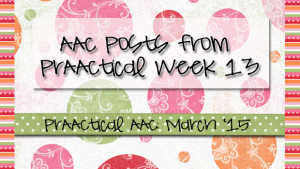
Monday: 5 Ways to Use Anchor Charts & Other Visual Supports in AAC Language Therapy Tuesday: PrAACtical Resources: Chronic Pain Assessment in Children with Disabilities Wednesday: Video of the Week – Lily Gets New Words! Thursday: Magic Moments with Toca Train by Nerissa Hall and Hillary Jellison
Filed under: PrAACtical Thinking
March 26, 2015
by Carole Zangari -
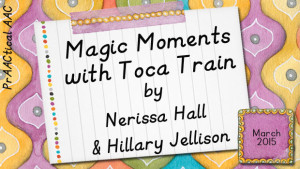
Many of us have worked with learners who have a special interest in trains, but even kids who don’t give trains more than a passing glance still generally love the Toca Train app by Toca Boca. In this post, we welcome back SLPs Nerissa Hall and Hillary Jellison of Communicare, LLC who share how they use Toca Train in their clinical work with young AAC learners. In addition to their prAACtical suggestions, they generously share a train-themed communication board and their data sheet for the phrases that can be targeted in this activity. iPad applications are fun and engaging, and can be a great addition to any clinician’s intervention toolkit. We use iPad applications to engage our learners in play-based activities that address a range of speech, language, and communication goals. One of our learners’ favorite applications is Toca Train; a bright and colorful application that involves a train moving around a track at different speeds, controlled... [Read More...]
Filed under: PrAACtical Thinking
Tagged With: Hillary Jellison, language intervention, Nerissa Hall
March 24, 2015
by Carole Zangari -
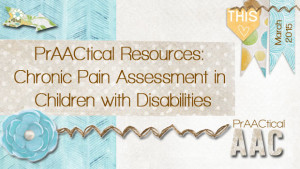
You don’t have to do AAC work for very long before you become acutely aware that many of our prAACtical friends experience chronic pain. We can all relate to the ways in which pain impacts a person’s behavior and participation in life experiences. Even very low-level pain can be terribly distracting, highly annoying, and cause us to have difficulty concentrating. From GERD to muscle spasms to constipation, children with AAC needs often experience pain that goes undetected or inadequately treated. In today’s post we look at some resources for assessing pain in children with disabilities. Thanks to Holland Bloorview Kids Rehabilitation Hospital for these fine resources. You can access their resources here and watch a brief video on pain in children with cerebral palsy here.
Filed under: PrAACtical Thinking
Tagged With: family, pain, resources
March 23, 2015
by Carole Zangari -
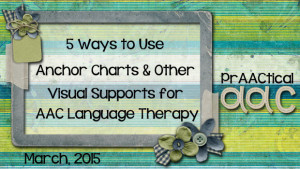
Anchor charts are a visual way to outline, describe, or illustrate a procedure, strategy, or concept. They are widely used visual supports in general education classrooms across the grade levels. In AAC therapy, anchor charts offer several benefits. First, making the anchor chart forces us to distill the main ideas in whatever it is we are teaching. What are the key aspects of what we are teaching? We have to answer that to create our anchor chart, and that gets us really thinking about the concept/process/strategy in great detail. Selecting the critical elements for our anchor chart helps us focus on the constructs that are most important to teach. Secondly, it helps us explain the concept/process/strategy in a more concise and articulate way. Putting things into writing forces us to clarify our explanations, and allows us to carefully consider what to say and how to say it. Yes, we sometimes... [Read More...]
Filed under: PrAACtical Thinking
Tagged With: AAC intervention, anchor charts, implementation ideas, visual supports
March 22, 2015
by Carole Zangari -
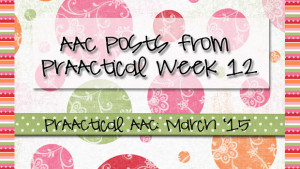
Monday: Core Concepts in Core Vocabulary Instruction Tuesday: PrAACtical Questions: “What Should I Program on the AAC Device?” Wednesday: Watch It Wednesday – AAC Goes to the Library Thursday: Make It PrAACtical: Mounting Board for a Walker
Filed under: PrAACtical Thinking









